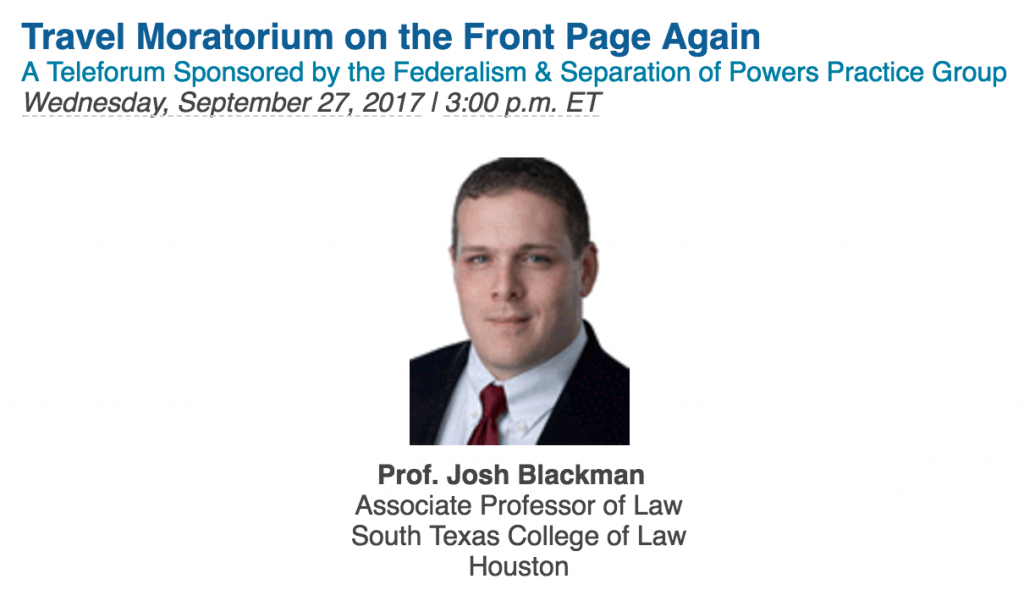This is the way Trump v. IRAP ends: not with a bang, but with a whimper. At least for now.
Two weeks after President Trump’s second travel ban expired, the Supreme Court vacated the Fourth Circuit’s en banc opinion with a four-sentence order. The Ninth Circuit’s judgment Hawaii v. Trump will likely be vacated in two weeks when the refugee ban expires. There was only one dissenting vote: Justice Sotomayor would have dismissed the writ of certiorari as improvidently granted without vacating the lower-court judgment.
The court’s bottom-line judgment should not come as much of a surprise. The most remarkable aspect of the unsigned order was its nonchalance:
We granted certiorari in this case to resolve a challenge to “the temporary suspension of entry of aliens abroad under Section 2(c) of Executive Order No. 13,780.” Because that provision of the Order “expired by its own terms” on September 24, 2017, the appeal no longer presents a “live case or controversy.” Burke v. Barnes, 479 U. S. 361, 363 (1987). Following our established practice in such cases, the judgment is therefore vacated, and the case is remanded to the United States Court of Appeals for the Fourth Circuit with instructions to dismiss as moot the challenge to Executive Order No. 13,780. United States v. Munsingwear, Inc., 340 U. S. 36, 39 (1950). We express no view on the merits.
Despite thousands of pages of briefing and more than eighty amicus briefs, the justices treated Trump v. IRAP according to “established practices” as they would in any other routine case. The citation to Burke v. Barnes (1987) is instructive: That case involved a challenge to President Reagan’s pocket veto by members of Congress. However, a few weeks after the D.C. Circuit entered its judgment, the “bill in question expired by its own terms.” Chief Justice Rehnquist explained, “it is not enough that there may have been a live case or controversy when the case was decided by the court whose judgment we are reviewing.” As a result, the Supreme Court vacated the district court’s judgment under the Munsingwear decision.
In the grand scheme of the constitutional law, Burke v. Barnes was unremarkable. I had never heard of it before its citation in the solicitor general’s letter brief. In any event, the court saw Burke v. Barnes as providing the rule of decision for IRAP.
The exceptions to mootness are flexible, in light of the voluntary cessation doctrine. Further, the exceptions to the fuzzy Munsingwear doctrine are even more pliable. Hawaii and the American Civil Liberties Union offered more than enough reasons for the court to keep the case on the calendar, and in the alternative, leave the precedents on the books. If the justices indeed viewed Trump v. IRAP as the next Korematsu, such exceptions could have been found with ease. None were warranted. Not even Justice Sotomayor agreed to keep the case on the Court’s docket, though she alone would have allowed the Fourth Circuit’s decision to stand.
Monday’s unsigned order continues a trend that I have chronicled over the last three months: At each juncture where the Supreme Court had the opportunity to hand the federal government a resounding defeat—a resistance to the normalization of President Trump—the justices have declined. If the Fourth Circuit was correct that the president’s order “drips with religious intolerance, animus, and discrimination,” then jurisdiction should have been maintained under the voluntary cessation doctrine. If the Ninth Circuit was correct that the president failed to meet the statutory criteria to exclude anyone, regardless of the constitutional issues, then there was no harm in allowing the lower court decision to stand. Yet, the Fourth Circuit decision is no longer precedential, and the Ninth Circuit decision will soon be wiped from the books. As I noted in my last post, these opinions “must be quarantined as byproducts of a judicial panic that should not be cited going forward.” And they shall not be cited.
It is true that the justices assiduously maintained that they “express no view on the merits,” but at this point, who are they kidding? If any of the findings of the Fourth and Ninth Circuit had merit, the justices should be falling over themselves to uphold civil liberties and vindicate the separation of powers. That hasn’t happened.
Eventually, this case will come back to the court on the merits. But this delay was not by chance. Rather, it was part of a deliberate strategy. As I explained last month, “despite the never-ending spate of nationwide injunctions, the government has always been in the driver’s seat.” Jeffrey Wall, the former acting solicitor general, has situated the government for a victory when few predicted it was possible. Critically, rather than considering the first or second iteration of the policy, the justices will eventually consider the third, and final, proclamation. When Justice Kennedy votes to grant a stay, in almost all cases, he votes to reverse. Since he voted to grant a stay on the earlier iterations of the policy, the likelihood of success for the latest proclamation—which is highly attenuated from the initial claims of animus—is on much firmer ground, especially in light of Monday’s vacatur.
Cross-Posted at Lawfare
